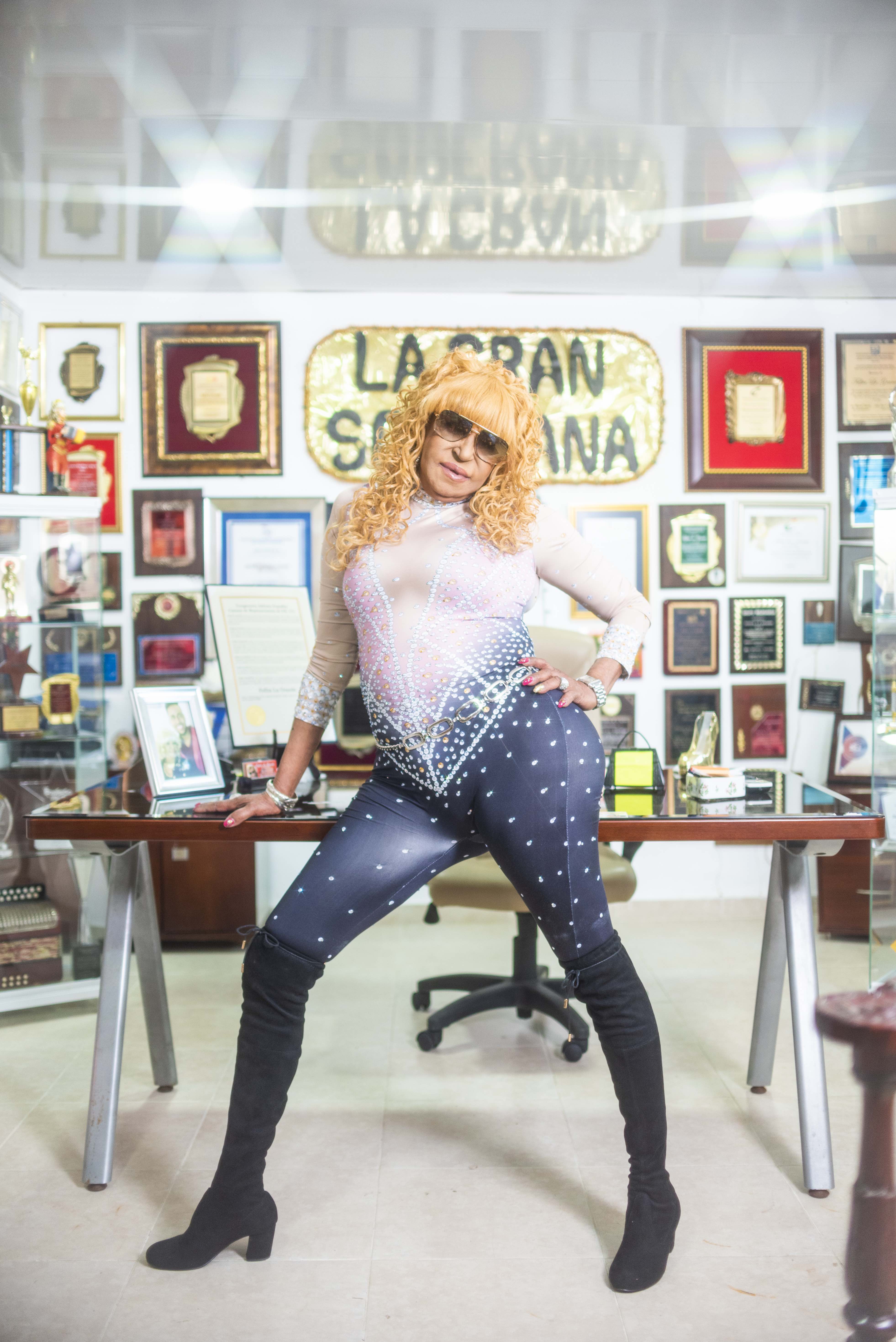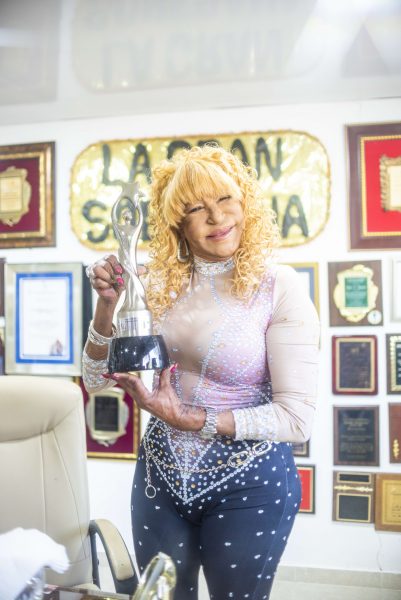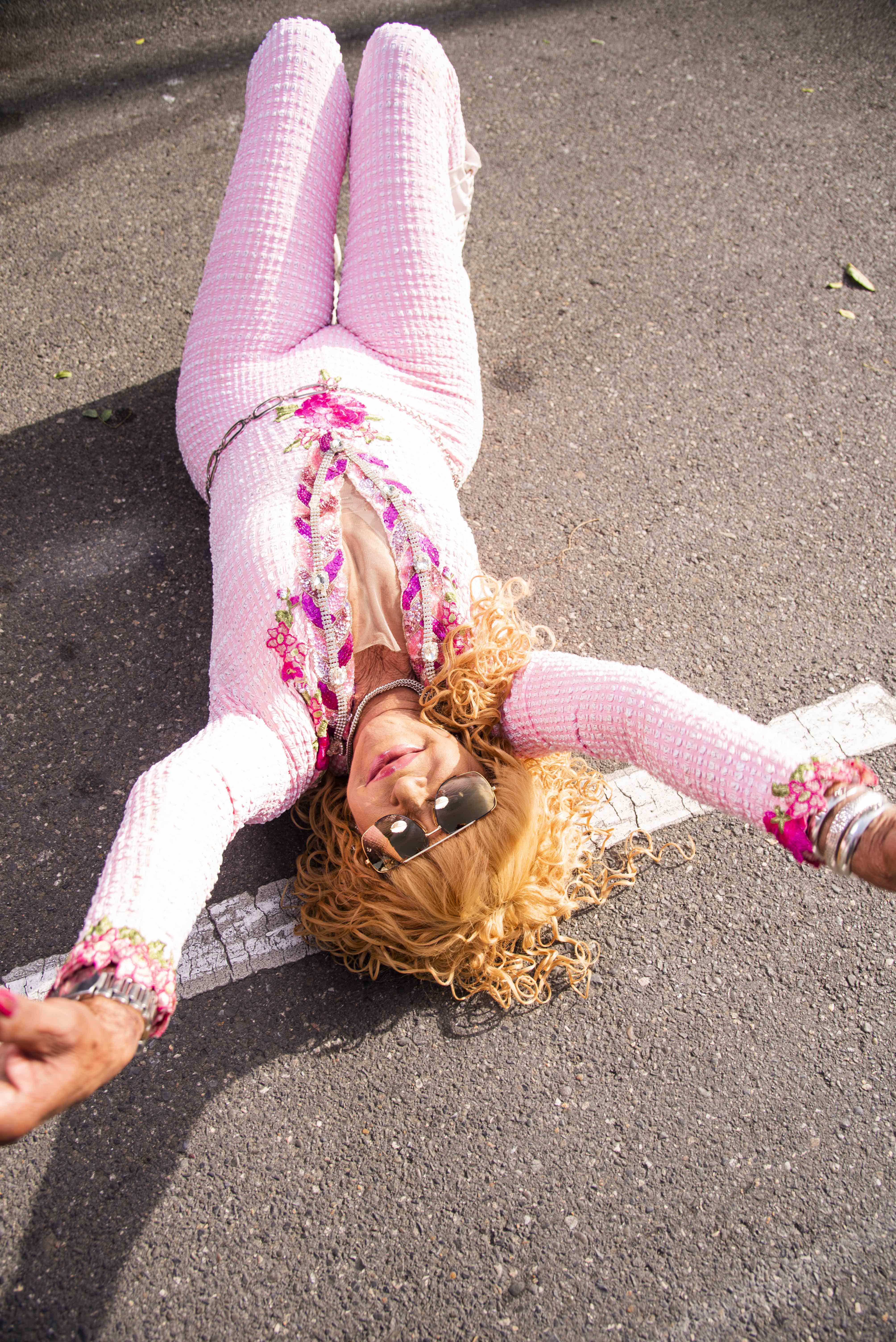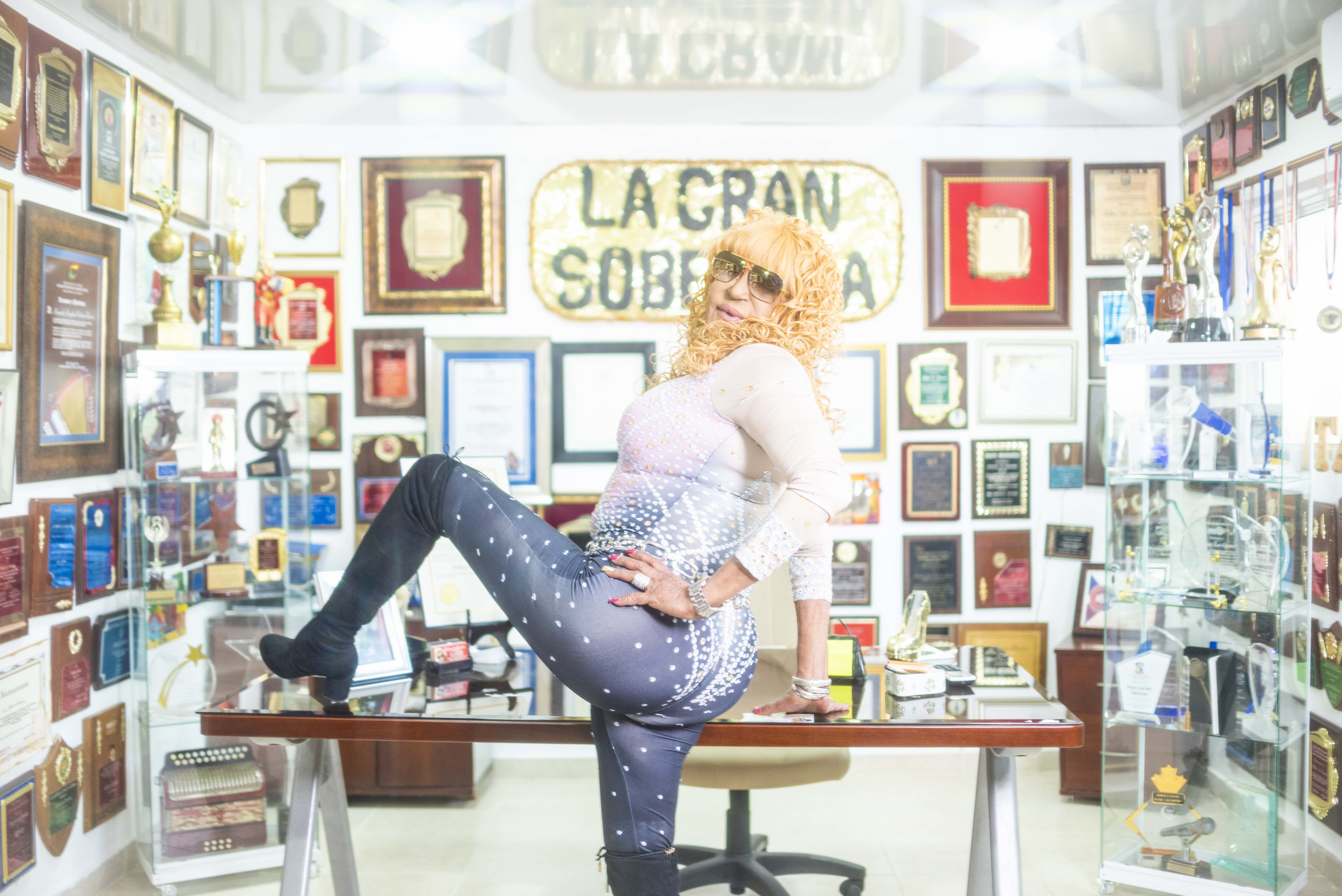Weeks before her 78th birthday, Fefita La Grande is dressed in full glam and lying down in the middle of the road. Rolling around in a flurry of poses for the photographer, holding up traffic somewhere near the city center of Santiago de los Caballeros, in the Dominican Republic, a crowd has gathered to cheer for the merengue icon. Children play in the street, and a man gets a fresh shape up on the sidewalk, all while Fefita smirks and struts by a towering mural of her likeness, emblazoned with her signature accordion and countless hit records. The commotion continues over at the nearby Monumento a Los Heroes de la Restauración. In this Santiago landmark, her magnetic presence rapidly attracts tourists, vendors, and police, all eager to greet and score a photo with the legendary star. Most pleased of all is Fefita herself, a consummate performer and beloved queen of the people, who after nearly two years of pandemic confinement, is ready to make a stage out of any lamp post or empanada stand.
Her uncanny ability to command every gaze and ear within a mile radius is the kind of fabled superpower legends are built on. And after 70 years of creating and performing music (56 of them professionally), Fefita La Grande’s herculean gravitas has far from waned. Hours prior to stirring joyful chaos at her photoshoot with Remezcla, Fefita held court in her Santiago home office, sitting behind a large wooden desk and surrounded by wall to wall, floor to ceiling plaques, trophies, and cherished mementos of a glorious but hard-fought career.


Shimmering behind her is a large embroidered banner that reads La Gran Soberana, or The Great Sovereign, referring to her 2016 lifetime achievement award from Dominican arts and entertainment institution Premios Soberano. Pomp and flattery aside, the title neatly encapsulates Fefita’s legacy as one of the last living bastions of a bygone era of Dominican musical tradition and a revered trailblazer within a genre that overwhelmingly remains a man’s game.
“I’m a proud campesina,” she says in a stately tone before chuckling and adding, “Few studies, but a tiny bit smart.”
Fefita La Grande’s intelligence is second only to her gumption. Manuela Josefa Taveras Cabrera was born in a small town called San José, in the nearby province of Santiago Rodríguez. Her father, Don Seito Cabrera, was a peanut farmer, rooster breeder, musician, and accordion repairman, while her mother Doña María Ana Cabrera raised the children, kept the house, and helped manage the land. Fefita and her sister Tatica were also tasked with chores like collecting water and feeding the animals. And while life was modest in rural 1940s Dominican Republic, the household was never left wanting.
One fateful day at the age of 7, she heard a song by merengue típico great Guandulito playing from a neighbor’s radio. The tune got stuck in her head, prompting Fefita to sneak into her father’s workshop, pick up an accordion, and, as she tells it, “I just started playing. I don’t know how, but I did. It felt natural since I was born in those instruments.”
Her parents were shocked, and soon after, everyone else was too. Of course, Fefita was not. Her dexterity on the accordion is such that her name and the instrument have become synonymous, the same way Jimi Hendrix is inextricable from his guitar and Tito Puente from the timbales. “Real merengue típico is ear-based,” she says, underscoring key differences between merengue born and perfected in El Cibao’s countryside versus the horn-heavy, big band hybrids of city merengue from the likes of Los Hermanos Rosario or the late Johnny Ventura, who she calls a brother. “You don’t study that. These days there are schools, and I accept that. But true típico of accordion, güira, and tambora, you can only learn by ear.”

At 8-years-old, destiny put Petán Trujillo on Fefita’s path, brother of Dominican dictator Rafael Leonidas Trujillo. During a visit to the family home, Fefita greeted their high-powered guest with a brashness that has become a hallmark of her mythos, instructing him to take a seat and listen to a merengue she had written for him.
“He was at a loss for words,” she remembers. “He asked, ‘Who wrote the merengue?’ and I said ‘me.’ Then he asked, ‘And who’s going to play it?’ and I said ‘Me.’ So I grabbed my accordion and sang, ‘Quiero un revolvito y me lo de Petán / Para defenderme si acaso me dan’ (I want a revolver from Petán / to defend myself if I ever get hit). He was stunned and gave me 100 pesos, which was like a million bucks back in the day. He asked what I was going to do with all that money, and I told him I’d give it to my dad so he could buy me a cow and I could make more money.”
Steadily, Fefita’s talent and hustle gained enough renown to catch the attention of merengue típico luminaries El Ciego de Nagua and Tatico Henríquez, both of whom became mentors and collaborators for the young performer. The latter dubbed her La Vieja Fefa in her early ’20s, long before she became known as La Mayimba and Fefita La Grande. During these early years and throughout the 1970s and ’80s, Fefita melded virtuosity with unmistakable tumbao, writing and recording some of her most emblematic cuts. “Vamos Hablar Inglés,” “La Pimienta Es La Que Pica,” “Si Quiere Venir Que Venga,” and her untouchable cover of popular standard “La Chiflera” cemented her as a dynamic performer and quick-witted lyricist, positioning her among the first merengueras to take her music overseas to the U.S. and Europe.
“I can’t deny [the novelty of] being a woman at this time, playing accordion, and, modesty aside, singing really lovely,” she reminisces. “But with great privilege, I enjoy the respect and affection of my male peers. Any artist can be on the stage —not even from the Dominican Republic, from anywhere—, and when Fefita La Grande arrives, Fefita La Grande ARRIVES. I have no rivals. There are no copies. I am unique!”
“When Fefita La Grande arrives, Fefita La Grande ARRIVES. I have no rivals. There are no copies.”
She is also the blueprint. For decades Fefita has been revered as one of the women pioneers of merengue, flanked by the likes of Milly Quezada and Las Chicas del Can, and specifically exulting the work of younger accordionists María Díaz and La India Canela. Her status has also loaded her words with influence. After criticizing Premios Soberano (formerly known as Premios Cassandra) in 1986 due to their lack of nominations for merengue típico, she was the first to win a statuette in the new category the following year. She is also frank about splitting her at-home and on-stage personas. Still, her outspoken nature has made her a lightning rod for controversy, fueling sexually charged gossip, surgery rumors, and ageist jokes. Rather than try and defend herself, Fefita learned to run with the chisme, embracing every headline and meme and turning it into free publicity and Instagram content that showcases her sense of humor and keeps her in control of the narrative.
“Fame and fortune is not for everyone, so whatever they say I am, I am,” she muses. “You know people like to embellish stories. If I say I broke a nail, people say I broke a finger. They ask my makeup artist about all the work I’ve had done on my face, and she tells them the truth: nothing. I am a cancer survivor, so I’ve had a few reconstructive surgeries, and I gave birth to six children, so I’ve had some liposuction. But I am a woman just like any other. I am a woman that’s full of life and gives life. And with any partner I have, I am a woman from the bed to the kitchen.”

Not all of Fefita’s controversies are click-bait, and back in 2001, she found herself in hot waters with the U.S. government after giving her daughter’s visa to a close family friend. They were caught and accused of visa fraud, which resulted in Fefita getting banned from visiting or working on U.S. soil until 2014 when she apologized publicly and was subsequently pardoned. The outrage was such she swore off recording new music, breaking her studio hiatus eight years later, and with the inability to tour in one of her biggest markets, she fell into a steep financial and professional slump. About a decade after her visa scandal, Fefita was dealt yet another blow: breast cancer. This time she chose to keep it quiet.
“I was afraid that if I said anything, my work would be affected even more, and I couldn’t afford that,” she remembers. “I was in treatment for close to two years, and I never stopped performing. The doctors thought I was crazy, but I would get out of chemo and run straight to the next show.”
Boasting a clean bill of health and being able to work freely once more, Fefita kicked off her comeback in 2014 with a blockbuster guest performance with Romeo Santos at Yankee Stadium, embarking on her own tour shortly after. While many have floundered in the paradigm music industry shift of recent years, Fefita has remained relevant by staying true to her wild self and collaborating with a new wave of artists that re-introduced her to a younger generation of fans.
“The first dembow I ever did was [“Tu No Eres Buena”] with Don Miguelo, and later I worked with El Mayor Clásico,” she says. “When I did the “Ven Meneate” Remix [in 2016], people tried to say that it wasn’t me. That it was someone else’s body with my face on it. But my fans spoke out, and I started getting even more calls from younger artists. The other day, this guy in Puerto Rico wanted to see if I would jump on a salsa track, and when I explained I didn’t sing that kind of music, he just said, ‘Mayimba, there isn’t an artist out there that doesn’t want to record with you because you can make throwing a rock look good.’ So from merengue típico to dembow, I’ve just had to sell it.”
Fefita’s charismatic Midas touch was enlisted once more just before our conversation when she was cast for a cameo in the viral music video for Tokischa and Rosalía’s “Linda” crossover. While the song is practically begging for a Fefita La Grande remix, it’s not the first time the merenguera has been tapped to display her acting chops on screen. She has appeared in nine feature films, including 2003’s Perico Ripiao and 2005’s La Maldición del Padre Cardona. She also adds a producer credit to her resume with a biopic helmed by Antonio Rubio in development, in addition to working on a new album titled La Dieta, squeezing in studio time whenever her busy touring schedule permits.
“As a traditional musician, I have been highly favored by the changes in merengue,” she says. “Before 2000, ‘músicos de tradición’ were making pennies. But since the kind of music I perform has become harder to find, I’m in higher demand now and paid much better. I’ve also learned to evolve, putting a little mambo on it because I know people enjoy that.”
“I’ve also learned to evolve, putting a little mambo on it because I know people enjoy that.”
Fefita La Grande’s life and work have left an indelible mark on Dominican music, culture, and history — loved by all, matched by none. With a glance through her office, you’ll see artwork hung next to awards, her father’s antique accordion sitting in a glass display case, and even the key to the City of Providence. Pictures with former presidents Joaquin Balaguer, Leonel Fernández, and Danilo Medina line the walls, underscoring the mighty swing of her public sway, even when she has remained fiercely apolitical and independent throughout the years.
“Sometimes I come into my office and look upon my belongings and achievements,” she reflects, eyes swelling with tears, “and I can’t deny how much I miss the stage. My whole life is the stage, my accordion, the applause, my people… I hope my fans don’t forget about me. I hope the memes don’t forget about me. I adore you and will be your Mayimba, your Vieja Fefa for all time.”

Writer: Richard Villegas; Photography: Maria Mejia; Photo Assistant: Ysmel Abreu; Makeup: Winny Mercedez; Artists Relations: Joel Moya; Production Assistant: Maria Guerrero; Photo Direction: Itzel Alejandra Martinez; Story Editor: Alexis Hodoyan; Design/Creative Direction: Alan Lopez







